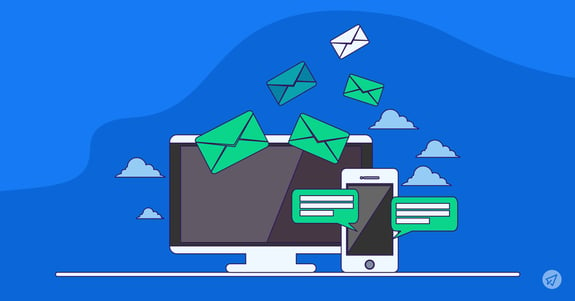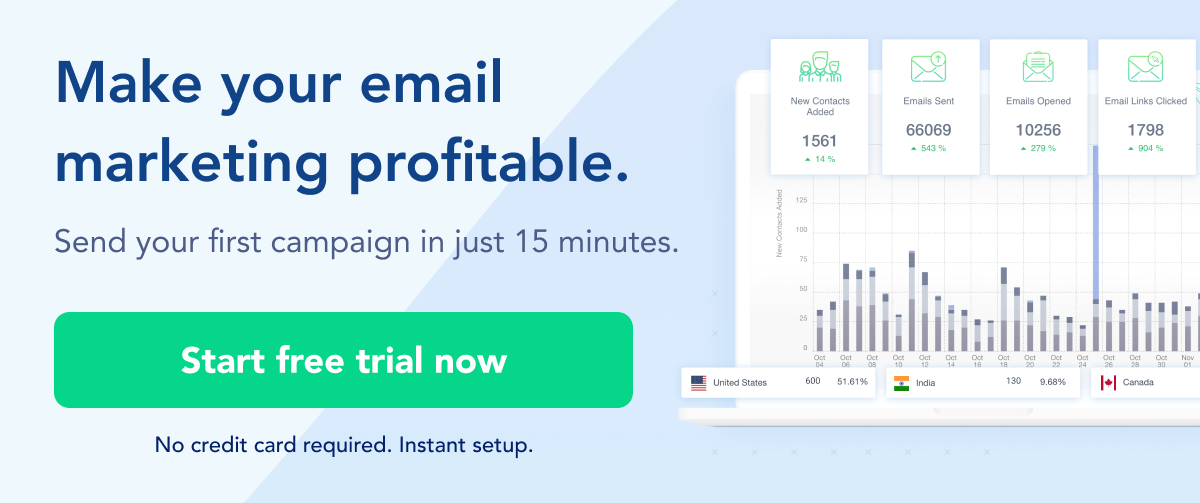Do you know that 77% of email marketers have witnessed a significant change in email engagement over the last year? It is proof of how powerful email newsletter campaigns are.
Email newsletters always provide significant value from a business perspective. These even contribute to the overall success of your businesses, brand, and online presence. However, many may wonder when the best time is to send the newsletters. Also, finding the right frequency and value is crucial to avoiding a high rate of unsubscribers.
Finding the proper balance between staying top-of-mind and avoiding subscriber fatigue is a challenging yet essential aspect of email marketing. While regular communication is vital for brand recall and customer loyalty, bombarding subscribers with excessive emails can lead to disengagement and unsubscribes.
This blog will help you explore all the factors influencing the frequency and determine how often to send a frequency for your specific business or brand email newsletters.
Table of Contents
Understanding Your Audience
The success of an email newsletter campaign depends on understanding and aligning with the preferences of the target audience. Also, around sixty-four percent of small businesses use email marketing to reach their target audience. However, this number is also predicted to increase in the next few years. So, understanding your audience's preferences is important for knowing the right email newsletter frequency.
Source: https://3.bp.blogspot.com/-hgVHegtyKPI/VrcWR2KAxQI/AAAAAAAAAOI/GRfC5ly07kI/s640/Mail%2Bmarketing.jpg
The importance of audience preferences in determining email newsletter frequency cannot be overstated. Your frequency of sending email newsletters to all users and consumers significantly impacts how your audience perceives your brand. This impacts the overall engagement of new and existing users with your content and, ultimately, the success of your email newsletter.
Hence, you should follow a proper plan that aligns with your strategy and fulfills your audience's needs and expectations.
Additionally, the industry you belong to can also influence your newsletter frequency. For example, if you run a business where information services are required, such as stock market updates, this might benefit people with frequent updates. Another example is if you’re a content creator whose subscribers pay you via a monetization platform like Patreon. If regular email updates are part of the subscription, a consistent frequency is expected.
On the other hand, if your business offers specialized services, such as a car repair company, you might continue with a less frequent schedule of sending emails to your consumers. So, it is necessary to research how to write a winning email, and then you can do it accordingly with the right frequency.
Source: https://www.mbaskool.com/2017_images/stories/jan-images/market-segmentation.jpg
Also, recognizing that not all subscribers are the same, using segmentation as a strategic tool for tailoring email frequency is essential. By categorizing subscribers based on demographics, behavior, or preferences, you can customize their communication approach for different audience segments. This ensures that each group receives a frequency of emails that aligns with their specific needs and expectations.
You can conduct proper surveys to ask your subscribers about their preferences directly. Use simple questions about how often they would like to receive emails and what content they find most valuable.
A Tip: Pay attention to comments and feedback to gather qualitative insights.
Factors Influencing Frequency
The frequency of sending the right email newsletter depends on various factors, and finding the optimal balance is crucial for maintaining engagement and avoiding unsubscribe rates.
Here are a few factors that influence the frequency of sending the right email newsletter:
1. Types of Content
The nature of content within email newsletters plays a pivotal role in determining the optimal frequency. Promotional content is often centered around sales and may necessitate a different frequency than informational content, which focuses on delivering valuable insights, tips, or educational material.
Also, newsletters with educational content, industry insights, or exclusive offers may be more readable and can get more open rates at a higher frequency than purely promotional emails.
If you have valuable and interesting content to share, subscribers are more likely to appreciate your frequent emails. However, if your content is repetitive or lacks value, subscribers may get annoyed with frequent messages.
- As per ProfileTree, the education industry had the highest open rate and the highest click-through rate at 28.5% and 4.4%, respectively. The retail industry as a whole has the lowest open rate (17.1%) and the largest annual increase in open rate (up 4.5%).
- These metrics clearly suggest that the type of content, ranging from educational to promotional, affects the open rate of the newsletter.
2. Industry Standards
Industry norms and standards can provide you with a lot of guidance. Some industries naturally lend themselves to more frequent communication, for example, the news updates daily deals, while others may benefit from a less frequent approach, for example, high-end products or specialized services.
In addition to this, by understanding how competitors engage with their audience, you can adapt your frequency to either differentiate yourselves or align with established expectations.
Analyzing the frequency of competitors' emails provides valuable insights into what resonates with the shared audience and informs a more nuanced and competitive approach to email marketing.
- 54% of marketers send out more than one email to their subscribers every month.
- For optimal results, Tuesdays are the ideal day to send emails; Sundays are the least effective.
So, it is necessary to evaluate what the customers like and what the competitors are doing to get more open rates and gain the trust of your audience.
Testing and Analyzing Engagement
You can use analytics and even A/B testing to determine the ideal frequency for your audience. Analyzing the open, click-through, and unsubscribe rates can help you learn the impact of different sending frequencies.
Conducting A/B testing is also great for comparing the different email frequencies. For instance, send one group a weekly newsletter and another a bi-weekly version.
Then, you should monitor their metrics like open, click-through, and conversion rates to identify trends.
According to Cognism, the highest email open rates are on Monday, 22%, and the lowest on Sunday, 20.3%.
Seasonal Considerations
Consider seasonal variations or specific events in your industry that affect the relevance and timing of your emails. Adjust your frequency accordingly during peak seasons or events.
For instance, during the holiday season, people are more active in their inboxes as they look for deals, promotions, and gift ideas. Consider increasing the frequency to take advantage of this heightened engagement.
If you have special sales or promotions, you might want to increase the frequency temporarily to keep your audience informed about limited-time offers. Additionally, to build anticipation and inform your audience, think about sending out more emails in the run-up to any forthcoming events, webinars, or product launches.
Subscriber Preferences and Feedback
When working on the right frequency setting for the email newsletter, you must ensure that the subscribers can easily opt out or adjust their preferences. This can help you reduce the number of unsubscribes caused by frequency issues, as users have control over the communication they receive.
In addition to this, it is also advisable that you collect proper feedback from your subscribers through some surveys or even through direct communication. In this way, you can better understand their preferences and even address their significant concerns, which can help you work better on your excellent email newsletter ideas.
Monitoring Unsubscribe Rates
Do you know that 69% of users unsubscribe from their email lists due to too many emails? As you continue working on your email newsletter campaigns, the chances are higher that you may lose many subscribers. Some reasons are unavoidable, but one of the biggest is too many and frequent emails. So, it is necessary to monitor the unsubscribe rates.
Sometimes, to avoid this situation and maintain a perfect balance between engagement and dealing with the risk of overcommunication, the best solution is to let your subscribers choose the email frequency they are most comfortable with. You should also give them the right to choose, which will reduce the number of unsubscribed users.
Automation and Drip Campaigns
No matter how many subscribers and customers you already have, how thoroughly and adequately you segment them, or how many email marketers you have in your team, you should use an affordable email marketing automation tool to automate the monotonous and time-consuming tasks while streamlining your workflow.
Also, mastering the drip campaigns and tailoring them according to the subscriber's behavior can help you nurture better leads. You can automate follow-ups, improve outreach, and even enhance the chance to free up a considerable amount of time, which can be spent doing other work and closing with hot leads. These are a few things that you should not miss while automating your emails.
Consistency and Predictability
To build and maintain a relationship with new and existing customers, sending consistent and regular emails is crucial. This helps you stay in touch with all the people who expect emails from their favorite businesses and brands.
Performing on predictability and working to meet the users' expectations can be done by sending a weekly or monthly email. This way, you can make them believe that you value them. Also, you can keep them constantly engaged, influence them, and push them closer to a purchase.
Conclusion
Understanding audience preferences, differentiating between content types, and adapting strategies based on industry standards is essential. By synthesizing these factors, you can develop a nuanced approach to email frequency that aligns with the unique characteristics of their audience, content, and industry.
Successful email marketing requires an ongoing commitment to understanding and adapting to the landscape of audience preferences. Therefore, finding the ideal email newsletter frequency is not a one-time task but a continuous refinement process. It can be achieved through email marketing strategies that remain agile and responsive, optimizing engagement by aligning with the evolving preferences of the audience.



